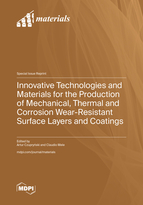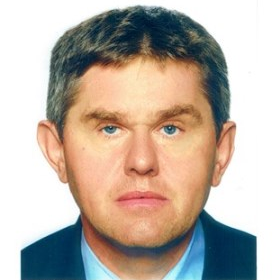Innovative Technologies and Materials for the Production of Mechanical, Thermal and Corrosion Wear-Resistant Surface Layers and Coatings
A special issue of Materials (ISSN 1996-1944). This special issue belongs to the section "Manufacturing Processes and Systems".
Deadline for manuscript submissions: closed (20 December 2022) | Viewed by 34671
Special Issue Editors
Interests: welding; hardfacing; thermal spraying; explosive cladding process; brazing welding; surface engineering; abrasive wear; erosive wear; anti-corrosion protection methods
Special Issues, Collections and Topics in MDPI journals
Interests: degradation of materials for batteries; Zn-air batteries; corrosion; electrochemical applications; spectroelectrochemistry
Special Issues, Collections and Topics in MDPI journals
Special Issue Information
Dear Colleagues,
Surface deterioration is a very real problem in many industries. Intensive wear of machine and apparatus parts in mining, quarrying, petrochemical, metallurgical, cement, construction, power generation, and many more industries is driving the increasing demand for innovative materials and technologies for the production of surface layers and coatings that are increasingly durable. Periodically occurring failures of machine elements caused by impact, abrasive, erosion, compression, cavitation, adhesive, corrosion wear, oxidation, thermal shock, or a combination of these leads to economic losses in the form of unplanned production downtime and are associated with the frequent requirement for replacement of parts and, in extreme cases, loss of health and life. During the wear process, the surface layer of material is degraded and damaged by mechanical, high temperature, or chemical reaction between the worn element and other elements or aggressive environments. During the prolonged wear process, weight loss and change of dimensions and shape of the subjected part are observed. These processes are observed under conditions of surface contact with metals, nonmetals, solid or liquid particles in a liquid medium, and flow of liquids. Wear intensity is a function of wear type, process parameters, and surface layer resistance. In principle, wear is the main factor influencing the reliability and durability of machines and products.
The effects of wear can be repaired using, among other things, welding technologies. Surfacing, coating, cladding, thermal spraying, galvanization processes with specialized welding filler materials are used to replace worn metal with metal that can provide more satisfactory wear resistance than the original. These technologies are also applied for the purpose of reducing wear or loss of material by abrasion, impact, erosion, oxidation, cavitation, corrosion, etc.
Many of the abovementioned types of wear occur in conjunction with others. It is wise to consider not only one factor but to look for a combination of factors that create the wear problem in order to determine the best type of surfacing material to apply. This is achieved by studying the worn part, the job it does, how it works with other parts of the equipment, and the environment in which it works. With these factors in mind, it is then possible to make a decision regarding selection of surfacing, plating, spraying, or galvanizing alloy. In order to properly select an alloy for a specific requirement, it is necessary to understand the wear phenomena that have occurred. Wear prediction proves to be difficult due not only to the dependence on material and design properties but also on difficulties in the quantification and control of tribological systems during the lifetime.
The purpose of this Special Issue is to present the latest developments in the field of research on innovative technologies and materials to produce surface layers and coatings resistant to mechanical wear, thermal wear, and corrosion.
The main topics of interest include but are not limited to the following:
- the study of modern welding technologies to produce surface layers and clads resistant to mechanical wear, thermal wear, and corrosion;
- the study of modern thermal spraying technologies to produce coatings resistant to mechanical wear, thermal wear, and corrosion;
- the study of modern braze cladding technologies to produce clads resistant to corrosion;
- the study of modern anticorrosion protection methods to produce coatings resistant to corrosion;
- the study of structure and mechanical properties of surface layers, coatings, and clads produced on metal substrate;
- the study of wear mechanisms of surface layers, coatings, and clads resistant to mechanical wear, thermal wear, and corrosion;
- the characterization of materials to produce surface layers and coatings resistant to mechanical wear, thermal wear, and corrosion;
- the characterization techniques for the innovative surface layers and coatings;
- the study of improved economics of production surface layers, coatings, and clads resistant to mechanical wear, thermal wear, and corrosion.
Dr. Artur Czupryński
Prof. Dr. Claudio Mele
Guest Editors
Manuscript Submission Information
Manuscripts should be submitted online at www.mdpi.com by registering and logging in to this website. Once you are registered, click here to go to the submission form. Manuscripts can be submitted until the deadline. All submissions that pass pre-check are peer-reviewed. Accepted papers will be published continuously in the journal (as soon as accepted) and will be listed together on the special issue website. Research articles, review articles as well as short communications are invited. For planned papers, a title and short abstract (about 100 words) can be sent to the Editorial Office for announcement on this website.
Submitted manuscripts should not have been published previously, nor be under consideration for publication elsewhere (except conference proceedings papers). All manuscripts are thoroughly refereed through a single-blind peer-review process. A guide for authors and other relevant information for submission of manuscripts is available on the Instructions for Authors page. Materials is an international peer-reviewed open access semimonthly journal published by MDPI.
Please visit the Instructions for Authors page before submitting a manuscript. The Article Processing Charge (APC) for publication in this open access journal is 2600 CHF (Swiss Francs). Submitted papers should be well formatted and use good English. Authors may use MDPI's English editing service prior to publication or during author revisions.
Keywords
- welding
- surfacing
- hardfacing
- cladding
- spraying
- wear
- erosion
- abrasion
- corrosion








